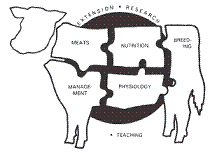Animal Science, Department of

Nebraska Beef Cattle Reports
Date of this Version
2009
Abstract
A total of 3,632 crossbred steers at three different sites (Nebraska, Colorado and Oklahoma) were utilized in a randomized complete block design (RCBD) study. Data were combined for the Colorado and Oklahoma trials. Steers were fed one of five treatments: 1) Traditional corn diet with Rumensin and Tylan (CORN+RT); 2) Wet distillers grains plus solubles (WDGS); 3) WDGS with Rumensin (WDGS+R); 4) WDGS with Rumensin and Tylan (WDGS+RT); and 5) WDGS with expanded dose range of Rumensin (44.4 g/ton) and Tylan (WDGS+HIRT) to evaluate the effects of Rumensin and Tylan in feedlot diets containing WDGS. In WDGS diets, feed-to-gain ratio (F:G) was improved when Rumensin and Tylan were included (P < 0.05). With the exception of dressing percentage, there were no differences in performance or carcass characteristics when Rumensin was fed at 33.3 g/ton compared to 44.4 g/ton. Treatments containing Tylan resulted in significantly fewer liver abscesses than other treatments. Cattle fed Rumensin and Tylan diets containing WDGS had improved F:G and decreased liver abscesses compared to those receiving diets with no additives, regardless of corn processing method.


Comments
Published in 2009 Nebraska Beef Cattle Report (Lincoln, NE: December, 2008). Copyright © 2008 The Board of Regents of the University of Nebraska.